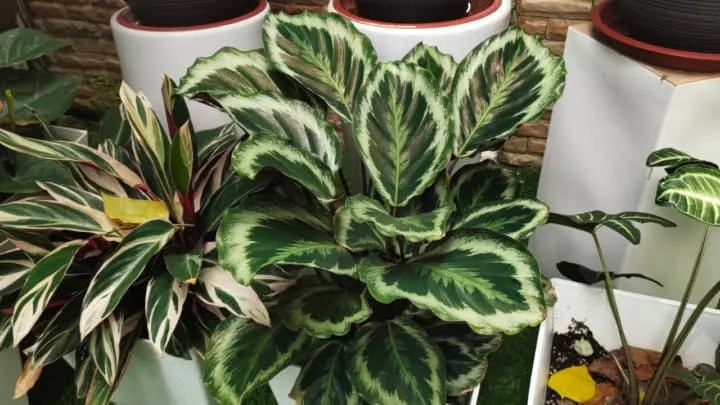After having success growing my Calathea Warscewiczii, I was excited to pop down to my local nursery and see if I could find other Calathea plants.
Starting a Calathea collection sounds like a fun project!
I was amazed at the variety of Calathea plants available. They are all stunning and offer different exotic colored foliage.
Some varieties even offer a display of beautiful whorled flowers.
If you provide a humid environment, damp soil, indirect bright light, and regular feeding, they will reward you with a spectacular display of tropical foliage.
Calathea plants have a natural habit of closing or folding their leaves as evening falls and reopening them when the sun rises.
This process is called nyctinasty. It also gives them the common name of ‘Prayer Plants’.
Let’s look at some of the Calathea Varieties that I found.
Table of Contents
12 Calathea Varieties
- Calathea makoyana (Peacock)
- Calathea ornata (Pinstripe)
- Calathea warscewiczii
- Calathea orbifolia (Round Leaf)
- Calathea crocata (Eternal Flame)
- Calathea roseopicta (Corona)
- Calathea beauty star
- Calathea misto
- Calathea vittata
- Calathea lancifolia (Rattlesnake)
- Calathea concinna (Zebra)
- Calathea fasciata
1. Calathea makoyana (Peacock)
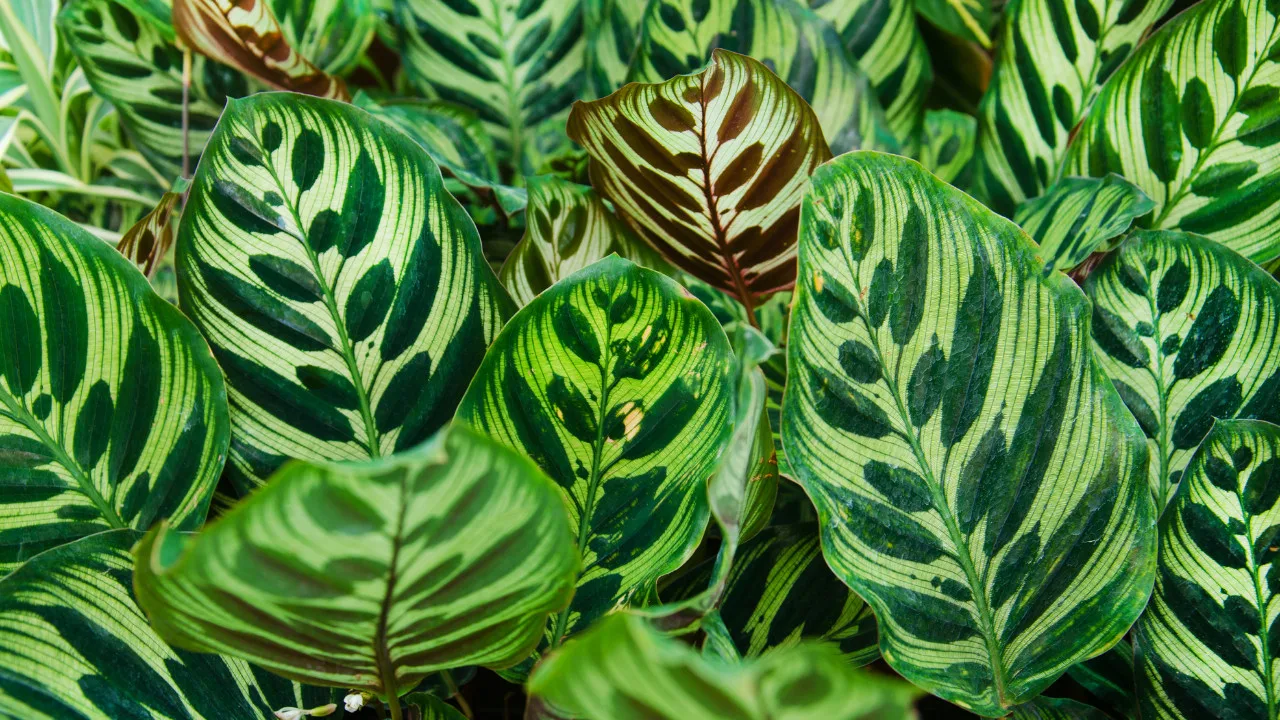
The beauty of this variety is perfectly embodied by its common names – the Peacock Calathea and Stained Glass Windows.
The leaves of this Calathea are pale green, covered with darker green lines that create a feather-like pattern. The effect is that of a stunning stained glass window as the name suggests.
For added drama, the undersides of the leaves are a lovely purple-pink shade.
This plant is native to East Brazil from the Espírito Santo state where it grows in tropical jungles that line the beaches.
This is a real show stopper and holds an RHS Award of Garden Merit.
Your Peacock Calathea does require lots of TLC. You will need to ensure that your indoor conditions are humid, warm, and filled with bright light for the plant to grow at its best.
Remember to use rainwater or distilled water when watering any Calathea plant.
2. Calathea ornata (Pinstripe)
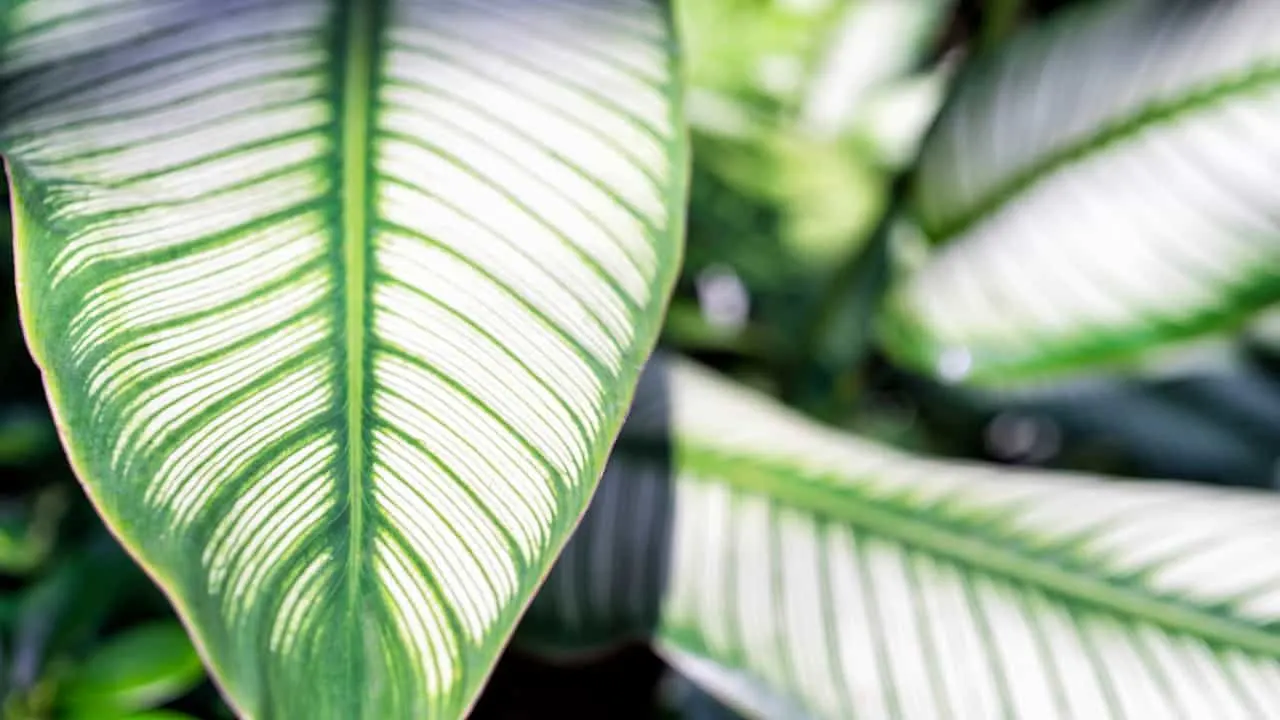
This delightful Calathea has the common name Pinstripe Calathea. Fashion lovers will understand the elegance and class of pinstripes! And your Calathea shows the same grace.
The leaves are longer and narrower than some other varieties. Like most Calathea plants, they have a rich, glossy finish.
The leaves are striped in tones of dark green interspersed with light pink and hot pink. The effect looks much like a hand-painted work of art.
As the plant ages, the pink stripes will tend to turn to a creamy white.
The leaf’s underside has a reddish-purple color.
Pinstripe Calathea is native to Colombia and Venezuela in South America.
When grown indoors the Pinstripe Calathea will reach a size of up to 2 feet (60 cm) tall and wide.
It makes a stunning display in an office or on a closed patio.
3. Calathea warscewiczii
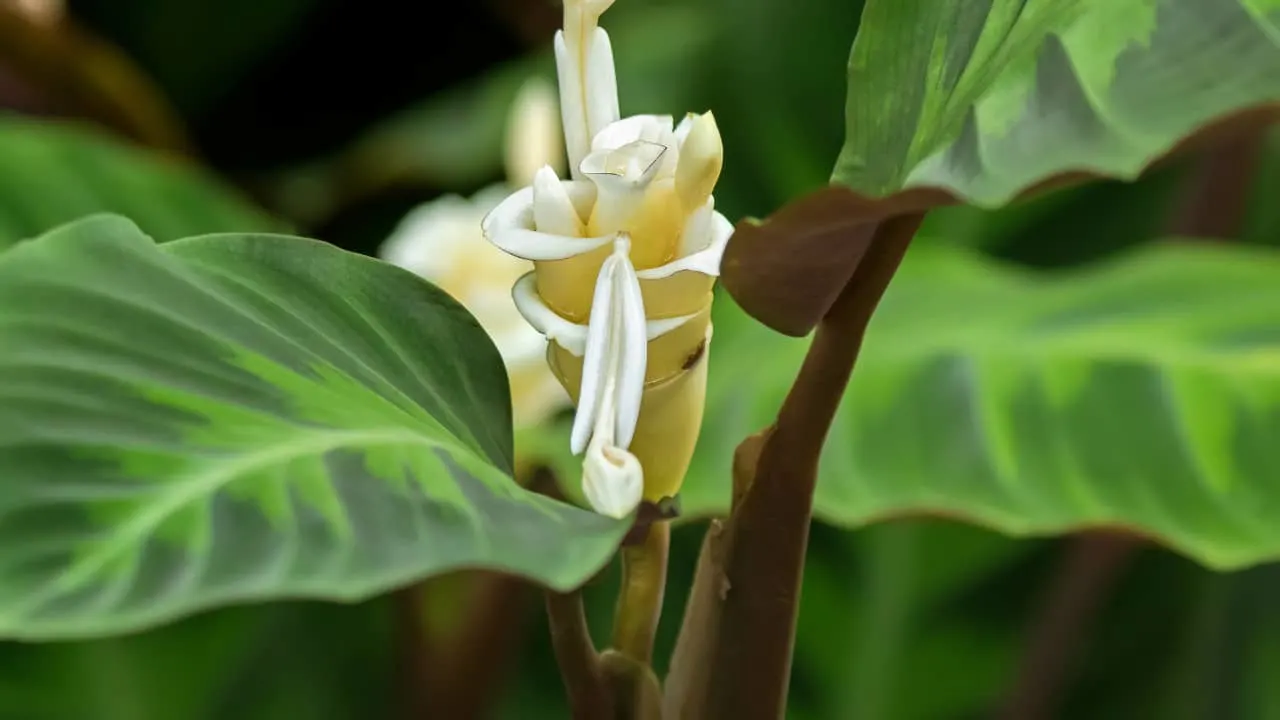
This variety delights the eye with its amazing foliage coloration.
The leaves have an oval lance shape. They display a unique fish-tail pattern in shades of light and dark green.
The undersides of the leaves are a fabulous contrasting bold burgundy-purple color.
This variety’s name comes from the famous Polish botanist, Józef Warszewicz. It is a tongue-twister to pronounce!
A more common name for this plant is the Calathea Jungle Velvet.
Its native habitat is Nicaragua and Costa Rica, where it grows in the tropical jungles.
As with many Calathea varieties, the leaves of the Jungle Velvet can reach a size of 12 inches (30 cm). The plant can grow up to a maximum of 3 feet (0.9 m) tall.
If you provide the perfect growing conditions of damp soil, high humidity, and bright indirect light, you will be amazed to see flowers blooming. These rare flowers appear in late winter and spring.
They grow from tall spikes and have a creamy-white color. Flowers will last for up to 3 to 4 weeks – make sure you snap a selfie with your bloom.
4. Calathea orbifolia (Round Leaf)
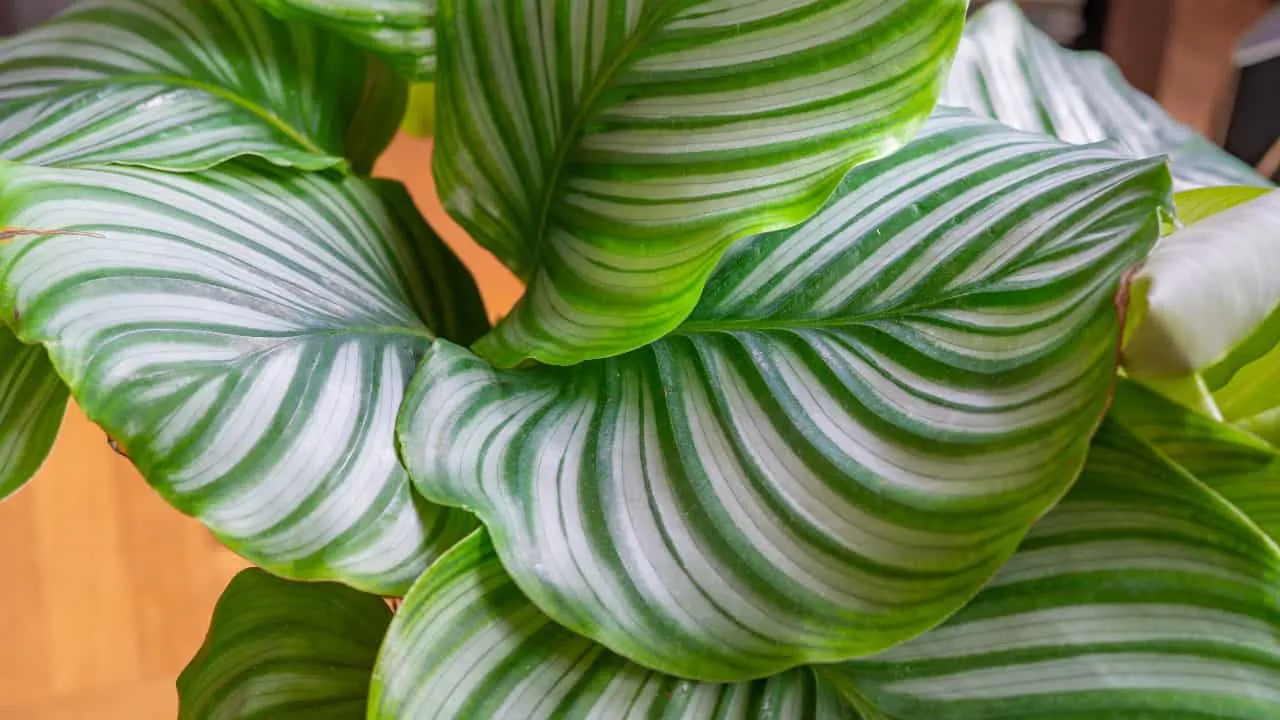
Calathea Orbifolia is native to Bolivia. It is also known as the Round Leaf Calathea.
It is the perfect plant to bring the tropical feel into your home.
As the name suggests, the leaves are a round shape. They display stunning stripes of cream, light green, dark green, interspersed with streaks of silver.
Leaves have a rich, glossy texture, making them look almost metallic.
Depending on your pot’s size, the leaves can grow as large as 12 inches (30 cm) wide. Plants that are mature can grow as tall as 2.5 feet (0.7m) and look awesome in a floor-standing container.
This is great Calathea to make a statement in your indoor garden, or on an enclosed patio.
5. Calathea crocata (Eternal Flame)
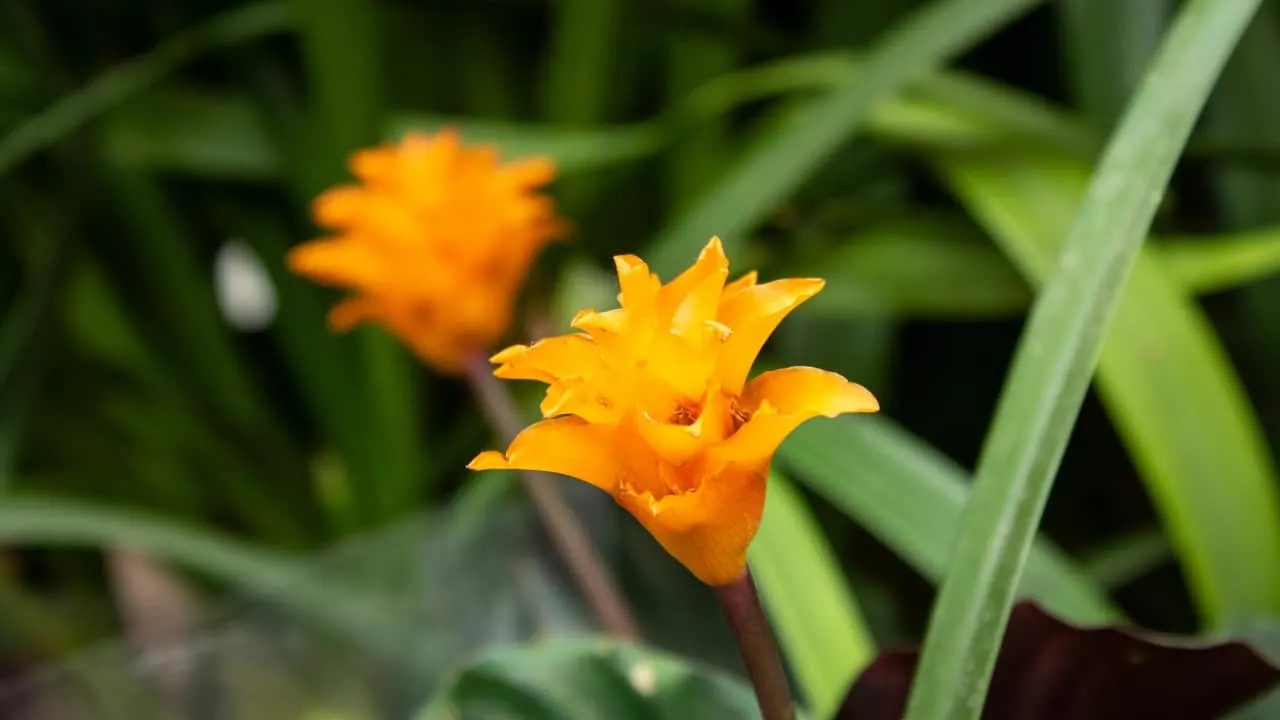
White many Calathea plants are grown for their stunning foliage, the Calathea Crocata is a variety that is grown for its amazing flowers and its foliage.
It offers large, eye-catching flowers in bold tones of yellow and orange. This gives it the more common name of the Eternal Flame Calathea.
It looks like a fiery display of flames in your home. It is sometimes called the Saffron-Colored Calathea.
The flowers offer a long bloom time of around 2 to 3 months. Once the flowers fade you can admire the glossy foliage.
The topsides are metallic dark green with purple hues. The undersides are a beautiful purple bronze.
This Calathea is slightly smaller than other varieties and will reach heights of 1 foot to 2 feet (30 cm to 60 cm) when grown indoors in a pot.
Eternal Flame Calathea is becoming difficult to find in its natural habitat in Brazil as a result of the destruction of the natural environment.
Even more reason to cultivate them in your home.
Like all Calathea’s, your plant requires care and attention. If you see that the leaves are curling inwards during the day, it means that you are not watering enough.
It is a Prayer Plant, so the leaves will curl naturally at night, this is normal.
6. Calathea roseopicta (Corona)
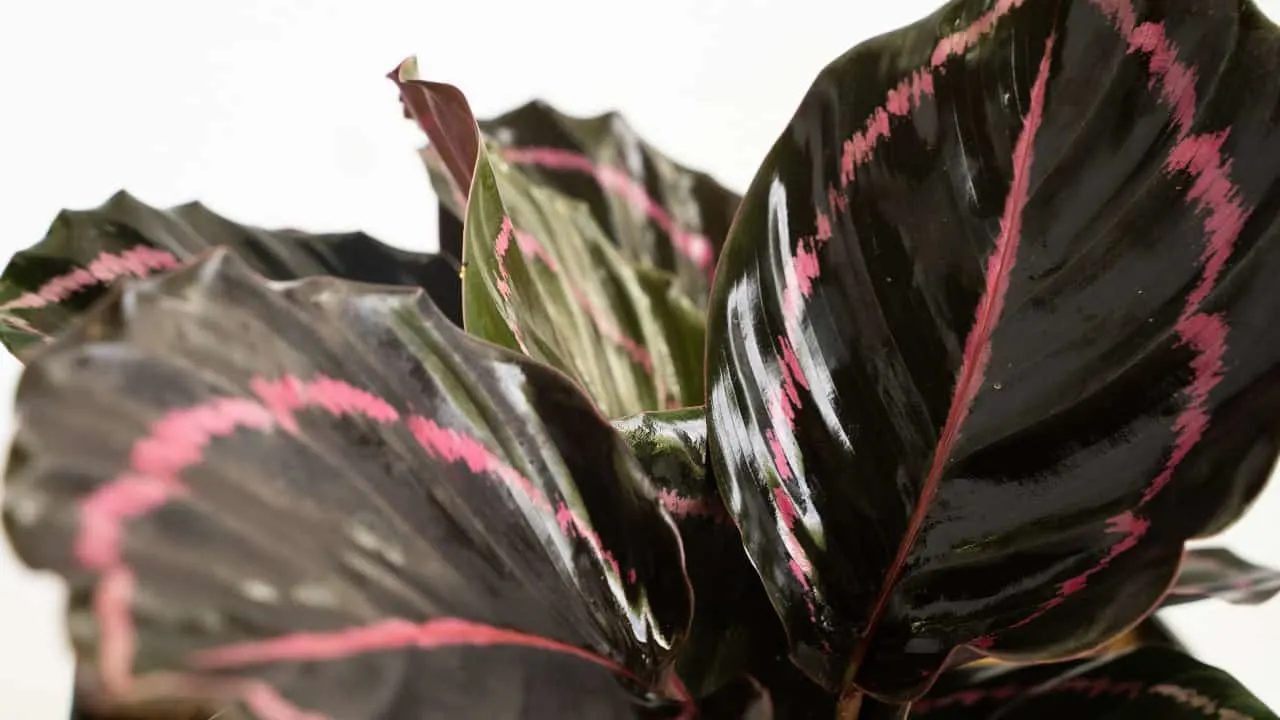
Calathea roseopicta offers large oval to round leaves that are gray-green in color. The leaves have a distinct dark green edging that makes them very attractive. The stems of the plant are purple-red.
It is sometimes called the Rose-painted Calathea due to the veins and midriff of the leaves that appear to be hand-painted with tones of pink.
The leaves also offer lovely feathered margins.
This is a very rare Calathea, native to northwest Brazil. It makes a stunning addition to a Calathea collection.
Calathea roseopicta is listed as an air-purifying plant. Air-purifying plants can help to remove toxins from your living space’s air.
So not only are they exceptionally beautiful to look at, but they increase your health too.
Like most Calathea’s the Corona is very fussy about chemicals in the water.
It is a good idea to carefully repot it every few years into fresh soil. This will remove the chemicals that build up in the soil from watering.
7. Calathea beauty star
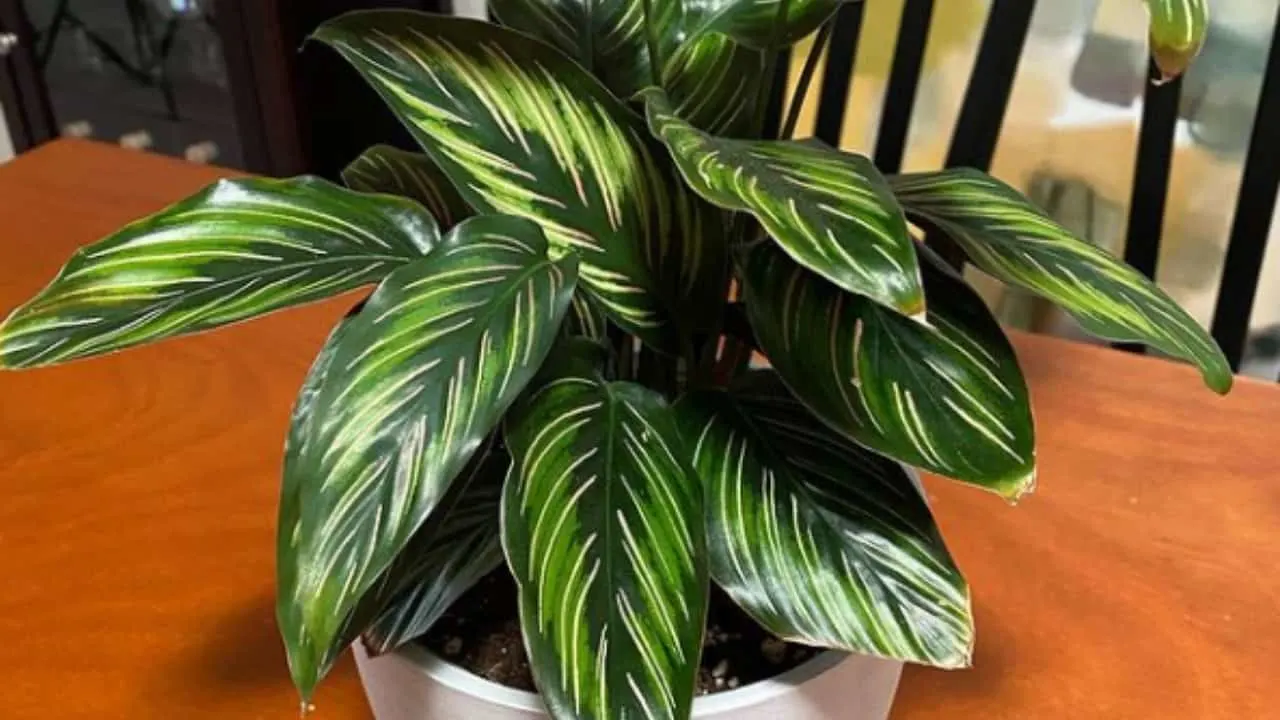
Photo Credit: @fonghwang on Instagram!
Calathea Beauty Star is also native to South America. This variety wows with its long, narrow leaves that are a vibrant dark green color.
The leaves are striped in paler tones of shimmering silver, light green, salmon pink, and contrasting white.
The leaves’ underside is a lovely aubergine color. Did you know that the darker purple-red hues of the underside of the leaves have a purpose – apart from being stunning to look at?
It is a natural adaptation that allows the plant to capture more light energy as the color reflects the light back up into the leaves.
It is truly a ‘Beauty Star’ with leaf patterns that have a feathery design. This is a must-have for any indoor tropical plant collector.
8. Calathea misto

Photo Credit: @flowerblossombyliz on Instagram!
The next stunning Calathea that caught my eye is the Calathea misto. This beautiful plant offers mid-green leaves. The centers have attractive light-green variegations.
The leaves are glossy and rich, and look as if they have been handpainted.
Calathea Misto is native to the tropical Americas. It is found growing under a canopy of other plants in rainforests.
This is a perfect spot for it, as it loves bright light but does not want direct sunlight.
The Misto is a great addition to a home collection. It looks great in a bathroom or on a kitchen island where it will benefit from the humid atmosphere.
It is one of the hardier and less fussy Calathea varieties. Some websites even classify it as easy to grow.
Ensure that it has moist well-draining soil, bright light, humid conditions, and lots of love.
9. Calathea vittata
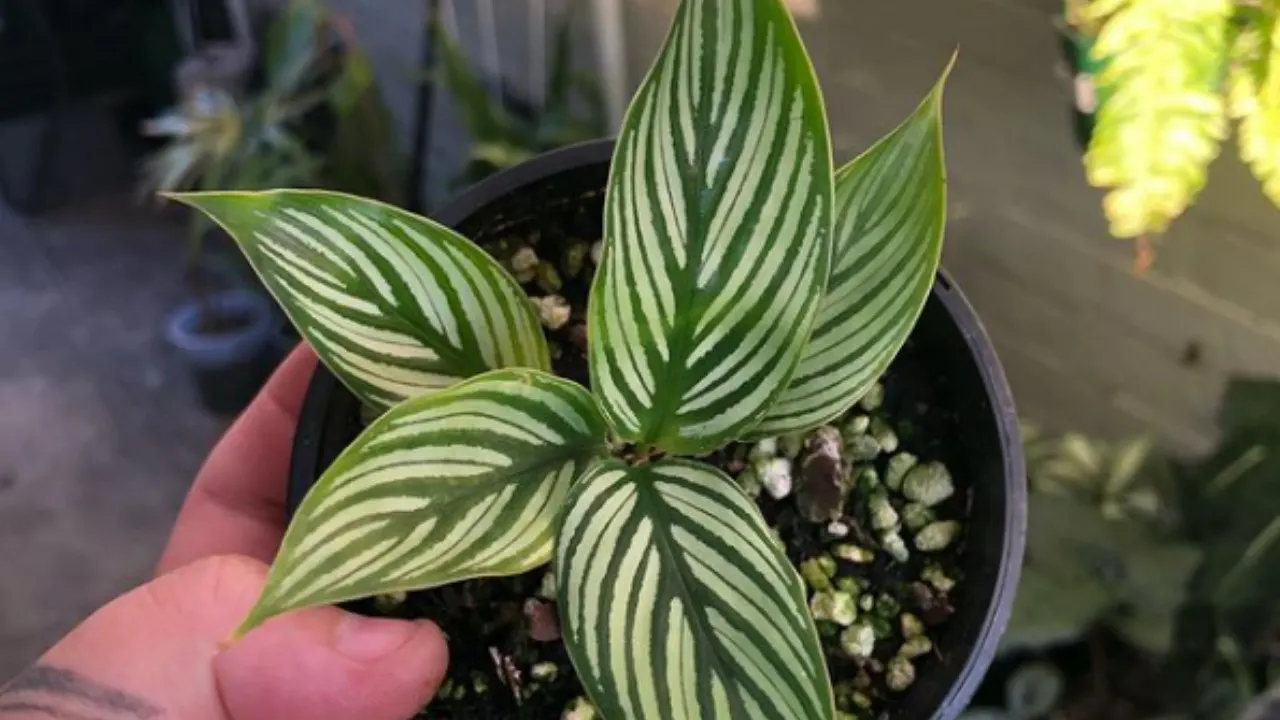
Photo Credit: @growinggrounds on Instagram!
Calathea vittata is native to South American rainforests where it grows under canopies of other plants.
It is not as demanding as some Calathea varieties and makes a fabulous addition to an indoor tropical plant collection.
Calathea vittata is known for its stunning, large tear-drop-shaped leaves. The leaves are dark green in color with bright yellow-green elliptical stripes.
But, if you find that its leaves start yellowing, better read on its possible reasons for prompt treatment.
The name vittata comes from the word vitta, which means a band or stripe of color.
Growing indoors in a pot, the plant can reach heights of up to 2 feet (60 cm).
This beautiful prayer plant closes up its leaves at night – a sight that must be seen to be appreciated. It is truly magical.
Calathea vittata is a great choice for a gardener who wants to start growing more fussy plants but doesn’t want a very rare variety that may die on you if you get it wrong.
10. Calathea lancifolia (Rattlesnake)
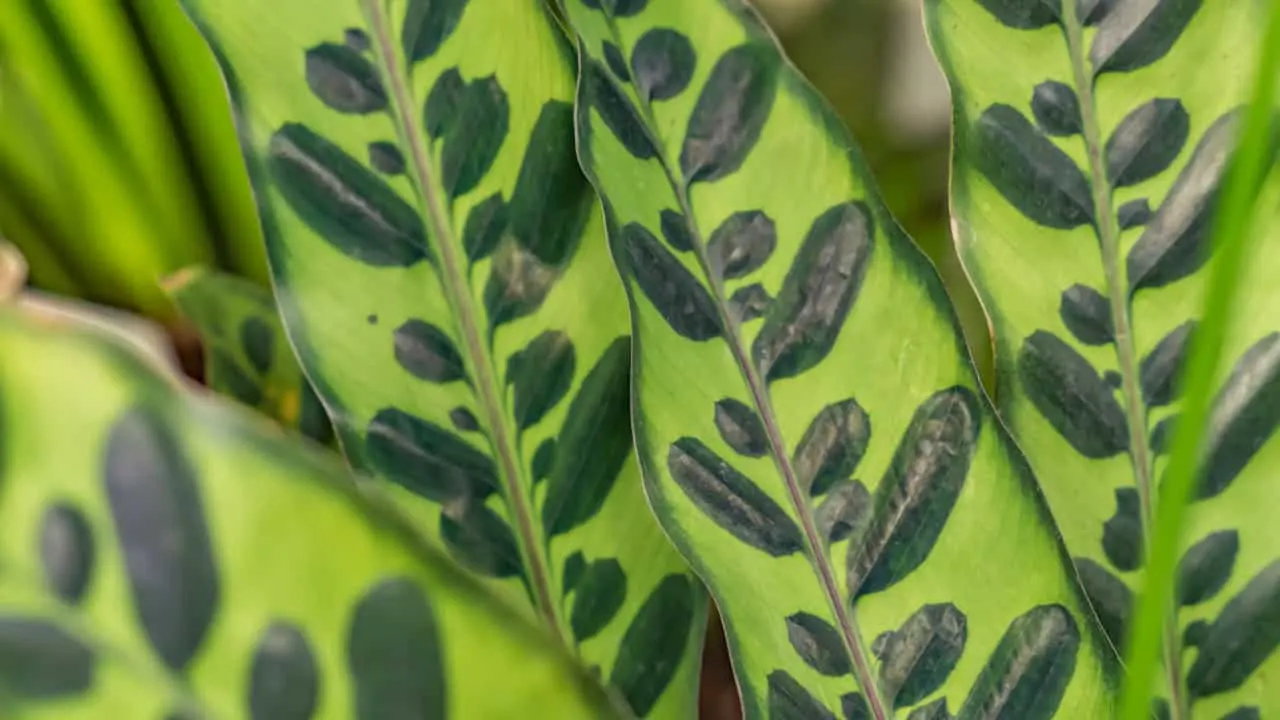
Although the Calathea lancifolia Rattlesnake has a scary name, it is not a threat!
The name comes from the long, narrow slim shape of the leaves that resemble a snake.
The leaves are a stunning mid-green color and are edged with dark green. Adding to the dramatic effect are dark green spots on the top side of the leaves.
The undersides are a deep red-purple color.
Unlike most Calathea plants which have smooth leaves, the Rattlesnake has attractive wavy leaves that are so eye-catching. A sure conversation starter when guests come over.
Rattlesnake is smaller than other Calathea varieties, making it a great choice for smaller indoor gardens. It is ideal to plant into a smaller pot to stand on a shelf or accent table.
Ensure that it gets loads of bright light, but no direct sunlight.
This plant is native to Brazilian rainforests. If you get your indoor environment spot-on, you may be rewarded with a show of bright yellow-orange blooms in late spring and early summer.
Don’t be discouraged if this does not happen. Calathea’s are fussy and the showy foliage is more than enough to keep any plant lover very happy.
11. Calathea Concinna (Zebra)
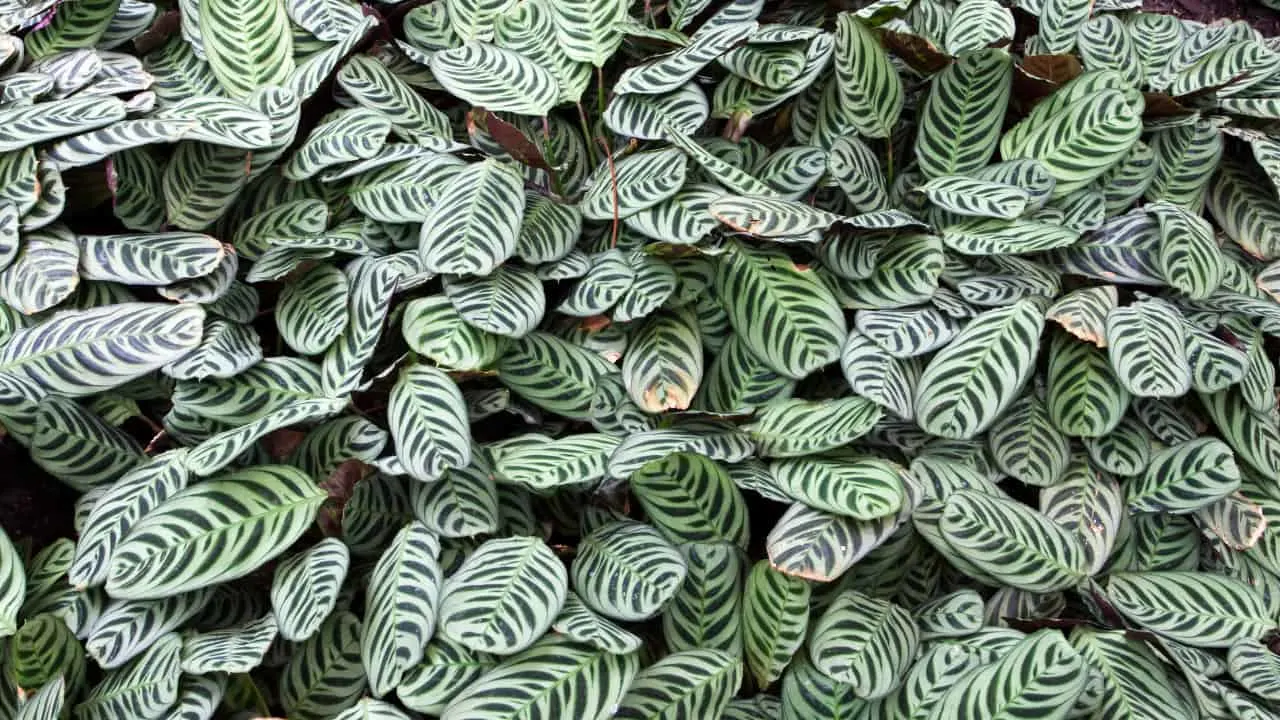
Calathea Concinna is also known as the Zebra Plant. You can guess – yes – the leaves have a stunning zebra or animal stripe design.
Like most Calathea plants, it is native to South America, particularly to the northwest regions of Brazil where it thrives in the rainforests.
The leaves of the Zebra Calathea are glossy dark green with creamy-white and light green stripes. Leaves are a wide lance shape and have a distinct dark green border around the edges.
This bold and attractive plant is a must-have for a home study or entertainment area.
It looks great in a decorative pot on a shelf, accent table, or in a bookcase nestling among your gardening books.
Calathea plants are not toxic. So they are ideal to have in homes with children and pets.
12. Calathea fasciata
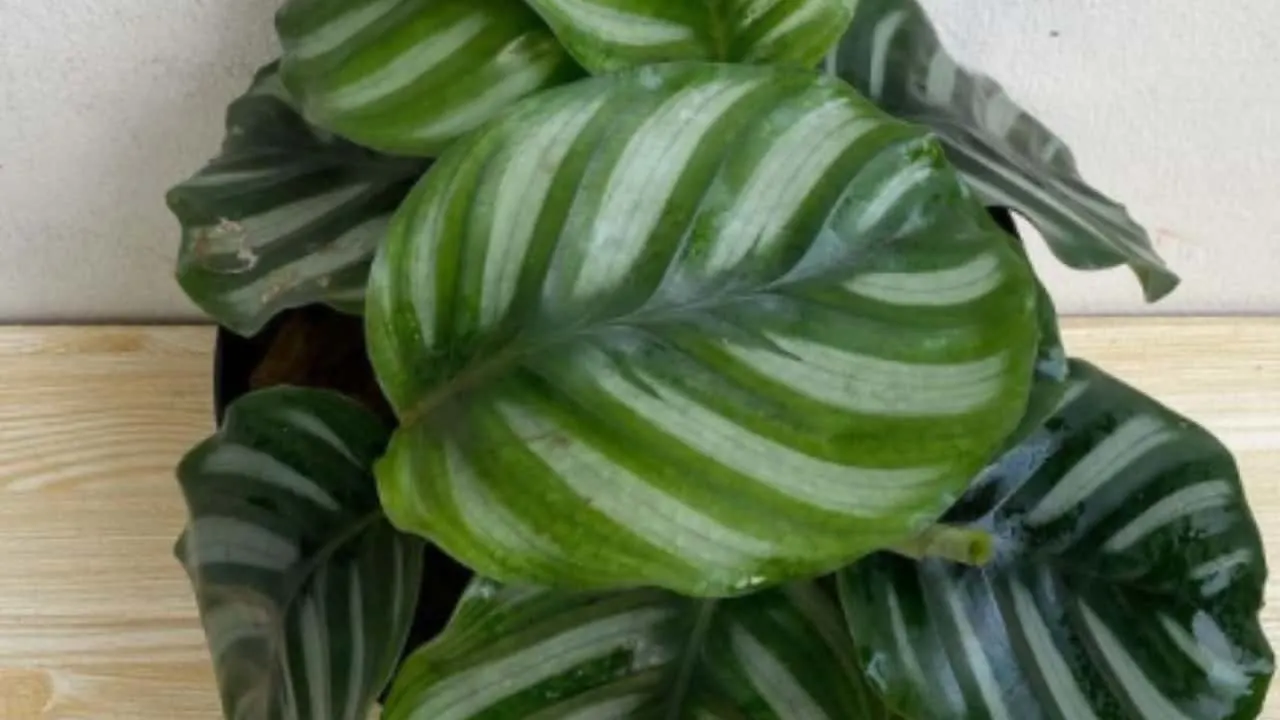
Photo Credit: @mygreenycorner on Instagram!
If you’re looking for another show stopper in your plant collection, then Calathea fasciata definitely is a must-have
Like the Calathea Rotundifolia variety, which by the way Rotundifolia in Greek means rounded leaf, you will see that this variety does offer beautiful rounded leaves.
The leaves have a leathery texture and are dark green in color. They have attractive lighter green bands that alternate with green-bronze bands.
The undersides are a deep purple adding to the sensational look.
This is an exotic plant that must become part of your tropical collection.
It does require more care and attention than your everyday house plants, but the reward of growing these exotic plants is certainly worth the effort.
If you are an avid indoor gardener and don’t yet have a Calathea to boast about now is the time to get one.

Daniel has been a plant enthusiast for over 20 years. He owns hundreds of houseplants and prepares for the chili growing seasons yearly with great anticipation. His favorite plants are plant species in the Araceae family, such as Monstera, Philodendron, and Anthurium. He also loves gardening and is growing hot peppers, tomatoes, and many more vegetables.

